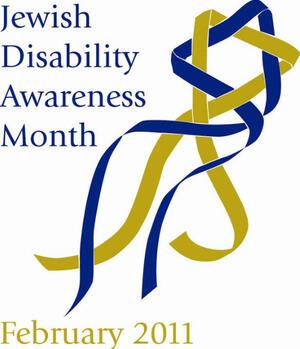Jewish Disability Awareness Month: What you should know
February is Black History Month. It’s also American Heart Month, International Boost Self-Esteem Month, National Snack Food Month, and Return Shopping Carts to the Supermarket Month. Yes, seriously. But for the Jewish community, this February also marks the 3rd annual Jewish Disability Awareness Month, described as “a unified effort to raise awareness and support efforts to foster inclusion of people with disabilities and their families in Jewish communities worldwide.”
I first became aware of Jewish Disability Awareness month in 2009, when I was working for the Reform Movement. Under the guidance of Rabbi Lynne Landsberg, Senior Adviser on Disability Issues for the Religious Action Center of Reform Judaism, the Reform Movement helped lead the way for the Jewish community to recognize the unique needs of people with disabilities and the many ways in which our synagogues can become truly welcoming. [Here’s where I should note that Rabbi Landsberg has since become a close friend and a personal mentor – but that doesn’t make the work she does any less meaningful or relevant!]
Rabbi Landsberg, who suffered a Traumatic Brain Injury following a car accident in the late ‘90s, is fond of saying, “The [Americans with Disabilities Act] guaranteed accessibility to public places. But nothing demands accessibility to the human heart.” She is passionate about helping the Jewish community and the larger faith community to recognize that serving the disabled among us means more than constructing a ramp or installing an elevator in our places of worship. It’s more than putting up signs in Braille and helping the elderly across the street. Since working with her, I now notice barriers to inclusion everywhere: in restaurants, at public events, even in my own synagogue.
What, then, does the “awareness” part of Jewish Disability Awareness Month mean? It means being cognizant of the needs of individuals with disabilities every step of the way when it comes to congregational and community planning. Think outside the traditional disabilities box, beyond ramps and onto questions like:
Are there elderly or impaired people in your community who may need a ride to services on Friday evenings? What about to local programs? Other important events, such as Voting Day?
- Is the print in your prayer books large enough for visually impaired people to read along easily, or might it be helpful to print off some large-print versions of the service?
- Is there space in your sanctuary for people with limited mobility to worship comfortably? Is your bimah accessible?
- If a child with autism or Down Syndrome – or deafness or blindness or cerebral palsy, or any number of disabilities – wanted to become a bar or bat mitzvah at your synagogue, are there tools in place to ensure he or she could do so with the necessary support and attention?
- Are all of your synagogue resources – brochures, prayer books, kippot, and the like – at a level reachable to individuals in wheelchairs?
- Does your congregation or community offer programming for or support to individuals who suffer from mental illnesses such as schizophrenia or bipolar disorder?
Truly, the scenarios are endless – but the more thought you give to them, the better prepared you’ll be to ensure that your corner of the Jewish community embraces people with disabilities into the fold in a way that says, “We want you here, and we will be as welcoming as we can possibly be,” rather than, “You and your disability are an afterthought, but we will try to be accommodating.”
All four major denominations of Judaism have embraced Jewish Disability Awareness Month as a time to help educate our community and make it a more welcoming place for Jews of all abilities. To learn more, visit the websites of any of the four movements: The Jewish Reconstructionist Federation, The Union for Reform Judaism, The United Synagogue of Conservative Judaism, and The Orthodox Union. A number of other Jewish organizations have added their voices to the fray, including: the Jewish Federations of North America, whose 19-page resource guide to inclusion; Yesodot, a Boston-based organization that serves Jewish and interfaith families affected by disability; The Religious Action Center of Reform Judaism, which co-founded the Interfaith Disability Awareness Coalition and lobbies for disability rights on Capitol Hill; and the Board of Rabbis of Southern California, which offers Jewish texts, stories and sermons on disabilities and Judaism.
This Jewish Disability Awareness Month and every month, keep in mind that not all Jews are the same. Just as we have different professions, different sexual orientations, different hair colors and different ethnic origins, so do we have different bodily abilities and mental statuses. Jewish scholar Yehudi HaKadosh said, “Good intentions alone not accompanied by action are without value. The main thing is the action, as this is what makes the intention so profound.” It’s up to us not just to think about being welcoming – but to do our best to actually be welcoming.








I have been looking to buy a kippah with the visual image of braille on it. Perhaps something like "Shabbat Shalom" in a braille font. Not tactile, but a picture of the braille words: something to get people thinking and talking. As someone who works with people who are blind and visually impaired, I find that braille items such as jewelry and possibly a kippah with a braille font on it is often a good ice breaker to get people talking about disabilities. Does anyone know where I can get something like this made? I only want one or two, so buying in bulk is not really an option since it is only for my own personal use.
Thanks for sharing it! One small point -- according to the RAC's JDAM webpage, 2009 was the first JDAM, so you were in on the ground floor.